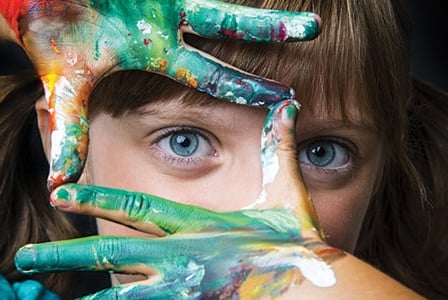
Creative kids are healthy kids! Learn why imaginative games, art, and music are more than just child\’s play.
If you’ve ever watched a child transform a cardboard box into a spaceship, then you’ve seen children’s inherent creativity at play. In many Canadian households, schoolwork, extracurricular activities, and screen time often take priority over unstructured creative pursuits, but creativity isn’t all fun and games—it’s also crucial for healthy development.
Pretend play
We called it playing pirates in the backyard; researchers call it “pretend play.” This type of play is initiated by the child, contains no predetermined rules, and involves make-believe. Research has shown that opportunities for pretend play help children grow into happy and well-adjusted adults.
Helen Hadani, PhD, associate director of research at the Center for Childhood Creativity, says, “Pretend play is especially important for children under age six because that is the time when almost all children naturally engage in pretend and fantasy play.” So why is play so important?
Cognitive processes
When children pretend they’re superheroes or fairy-tale characters and imagine creative ways to save the world or seek buried treasure, they develop important problem-solving skills. According to Hadani, children who play more also tend to be more advanced in language, memory, and reasoning, and have a better understanding of other people’s thoughts and beliefs.
Emotional processes
Through pretend play, children experience and react to a range of different emotions. When children play house, imagining they’re “mommy” or “daddy,” they role-play love, joy, and frustration (for example, as they attempt to stop their baby doll from crying). Because they imagine these emotions, they learn how to control their reactions to them, which helps them to handle future experiences and emotions in the real world.
Art and music
When children put paintbrush to paper or strum noisily on a ukulele, they can express themselves in a way they can’t with words alone. For children whose language skills are not fully developed, art and music are powerful media for exploring the ways in which they view the world.
Motor skills
Many of the motions involved in art and music, such as holding a pencil or playing piano keys, are crucial for the development of fine motor skills.
Creative problem-solving skills
The arts teach children that there is more than one way to see the world, and to be comfortable with ambiguity. There isn’t one “right” way to paint a tree or mould a sculpture out of clay.
Toys and supplies
Hadani recommends looking for toys that “foster many different types of play—pretend, co-operative, and physical—because they tap into many different aspects of development.” Building blocks, puzzles, and modelling clay can help awaken children’s creative thinking and can be enjoyed solo or with friends. For artistic endeavours, choose plain paper over colouring books, which can stifle creativity.
Toys and art supplies don’t have to be expensive. At home, fill an art box with inexpensive coloured paper, feathers, glue, glitter, and even old recyclables such as cereal boxes and yogurt containers. Fill a costume box with old jewellery, hats, shoes, and other costumes that you can find at garage sales and thrift stores, or in the back of your own closet.
What about technology?
There’s a place for certain age-appropriate games and apps for toddlers and kids, and Hadani notes that “there is no doubt that iPads can be lifesavers for parents on airplanes and long car rides.” However, she stresses that parents must carefully monitor young children’s screen time.
According to the Canadian Sedentary Behaviour Guidelines, screen time is not recommended for children under age two, should be limited to less than one hour per day for children ages two to four, and to no more than two hours per day for children ages five to 17.
In the absence of stimulation, kids will often turn on the television or tablet. However, creativity suffers from too much screen time. Kids need to have “stand and stare time” where they can come up with creative ways to respond to boredom through play, art, or by simply reflecting on their own ideas and observing the world around them.
Ways to cultivate creativity
Parents play a critical role in nurturing their children’s creativity, but many wonder how to infuse more creativity into their routines. Hadani stresses that “the key is to foster a sense of creative confidence in children so they are not afraid to express their unique ideas.” Here are some other tips.
Let kids get messy
When children are worried about making a mess, their creativity is inhibited. Create a designated play area in your home where children can get messy. If your home cannot accommodate this, have large tablecloths on hand to protect tables and floors, and some old, oversized T-shirts to pull on over kids’ clothes. Really messy projects can be taken outside or to the garage.
Make creativity accessible
Have plenty of different creative materials at home and store them in large bins where children can reach them for easy access and cleanup. And be ready for creativity anywhere—pack crayons and paper with you to ignite creativity while waiting at a restaurant or the dentist’s office.
Create with your children, but not for them
Sometimes well-meaning parents give too many instructions, which can dampen children’s creativity. Ask a lot of open-ended questions (for example, have them describe their drawing rather than asking, “Is this a bird?”); refrain from criticism by not telling them how it “should” be done. Most importantly, let loose and have fun with your child.
Fill your home with inspiration
When you feel stimulated at home, so will your children. Play music throughout your space, have musical instruments around, and fill your walls with colourful artwork, including your children’s own masterpieces.


